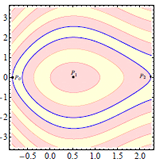Φ-ecuación de Tricomi
Main Article Content
Keywords
Soluciones periódicas, atractores, estabilidad
Resumen
Se estudia una ecuación diferencial no lineal autónoma que modela el movimiento de un Φ-péndulo amortiguado con forzamiento constante. En el caso disipativo se presentan dos resultados, por un lado, usando la aplicación de Poincaré y funciones de energía, se establece un criterio suficiente para determinar la existencia, unicidad y estabilidad asintótica de una solución periódica de segunda clase y por otro lado, se presenta un criterio con el que se estima analíticamente la cuenca de atracción de un equilibrio asintóticamente estable con ayuda del principio de invarianza de Lasalle. Mientras que en el caso conservativo se dan condiciones necesarias para que la imagen de la función periodo esté definida en un intervalo no acotado. Los resultados obtenidos en el caso disipativo son una generalización de los establecidos por Tricomi en el caso newtoniano.
Descargas
Referencias
[2] C. Chicone, Ordinary Differential equations with Applications, 3rd ed., Sprin-ger, Ed. Springer, 2006. 12
[3] M. W. Hirsch, S. Smale, and R. L. Devaney,Differential Equations, Dyna-mical Systems An Introduction to Chaos, 3rd ed. Elsevier, 2004. 12, 20
[4] J. Mawhin,Handbook of Differential Equations: Ordinary Differen-tial equations. Elsevier, 2004, vol. 1, ch. Global Results forthe Forced Pendulum Equation, pp. 533–589. [Online]. Available:http://www.sciencedirect.com/science/article/pii/S1874572500800085 12,14
[5] F. Tricomi, “Integrazione di un’equazione differenziale presentatasi in elettro-tecnica,”Annali della Scuola Normale Superiore di Pisa- Classe di Scienze,vol. 2, pp. 1–20, 1933. 12
[6] ——, “Sur une équation différentielle de l’électrotechnique,”Comptes RendusMathematique Academie des Sciences, Paris., vol. 193, pp. 635–636, 1931. 12
[7] R. Martins, “The effect of inversely unstable solutions on the at-tractor of the forced pendulum equation with friction,”Journal ofDifferential Equations, vol. 212, pp. 351–365, 2005. [Online]. Available:http://www.sciencedirect.com/science/article/pii/S0022039604002657 13
[8] ——, “The attractor of an equation of tricomi’s type,”Journal ofMathematical Analysis and Applications, vol. 342, 2008. [Online]. Available:http://www.sciencedirect.com/science/article/pii/S0022247X08000371 13
[9] J. Guckenheimer and P. Holmes,Nonlinear Oscillations, Dynamical Systems,and Bifurcations of Vector Fields, Springer, Ed. Springer, 1997. 13
[10] M. Levi, F. C. Hoppensteadt, and W. L. Miranker, “Dynamics of thejosephson junction,”Quarterly of Applied Mathematics, vol. 36, pp. 167–198,1978. [Online]. Available: http://www.jstor.org/stable/43636917. 13
[11] G. Carapella, G. Costabile, N. Martucciello, M. Cirillo, R. Latempa,A. Polcari, and G. Filatrella, “Experimental realization of a relativisticfluxon ratchet,”Physica C, vol. 382, pp. 337–341, 2002. [Online]. Available:http://www.sciencedirect.com/science/article/pii/S0921453402012327 13
[12] A. Kuijper, “p-laplacian driven image processing,”2007 IEEE InternationalConference on Image Processing, vol. 5, pp. V–257–V–260, Septiembre 2007.13
[13] J. Tome ̆cek, “Periodic solution of differential equation withφ-laplacianand state-dependent impulses,”Journal of Mathematical Analysisand Applications, vol. 450, pp. 1029–1046, 2017. [Online]. Available:http://www.sciencedirect.com/science/article/pii/S0022247X17300781 13
[14] J. Burkotová, I. Rachůnková, M. Rohleder, and J. Stryja, “Existence anduniqueness of damped solutions of singular ivps with phi-laplacian,”Elec-tronic Journal of Qualitative Theory of Differential Equations, vol. 121, pp.1–28, 2016. [Online]. Available: https://doi.org/10.14232/ejqtde.2016.1.12114
[15] Z. Do ̆slá, M. Cecchi, and M. Marini, “Asymptotic problems for differen-tial equations with boundedφ-laplacian,”Electronic Journal of QualitativeTheory of Differential Equations, no. 9, pp. 1–18, 2009. 14
[16] H. D. R and P. Radu, “Existence, localization and multiplicity ofpositive solutions toφ-laplace equations and systems,”Taiwanese JournalOf Mathematics, vol. 20, no. 1, pp. 77–89, 2016. [Online]. Available:https://doi.org/10.11650/tjm.20.2016.5553 14
[17] U. Kaufmann and L. Milne, “Positive solutions for nonlinear problemsinvolving the one-dimensionalφ-laplacian,”Journal of Mathematical Analysisand Applications, vol. 461, no. 1, pp. 24–37, mayo 2018. [Online]. Available:http://www.sciencedirect.com/science/article/pii/S0022247X17311447 14
[18] S. Pérez-González, J. Torregrosa, and P. J. Torres, “Existen-ce and uniqueness of limit cycles for generalizedφ-laplacian lié-nard equations,”Journal of Mathematical Analysis and Applica-tions, vol. 439, no. 2, pp. 745–765, 2016. [Online]. Available:http://www.sciencedirect.com/science/article/pii/S0022247X16002225 14
[19] P. J. Torres, “Nondegeneracy of the periodically forced liénard dif-ferential equation withφ-laplacian,”Communications in ContemporaryMathematics, vol. 13, no. 2, pp. 283–292, 2011. [Online]. Available:https://www.worldscientific.com/doi/abs/10.1142/S0219199711004208 14
[20] J. A. Wright, J. H. Deane, M. Bartuccelli, and G. Gentile,“Basins of attraction in forced systems with time-varying dissi-pation,”Communications in Nonlinear Science and Numerical Si-mulation, vol. 29, no. 1-3, pp. 72–87, 2015. [Online]. Available:http://www.sciencedirect.com/science/article/pii/S1007570415001471 14
[21] A. Cabada and F. A. Fernández, “Periodic solutions for some phi-laplacianand reflection equations,”Boundary Value Problems, vol. 2016, no. 1, p. 56,Feb 2016. [Online]. Available: https://doi.org/10.1186/s13661-016-0565-z 14
[22] L. Perko,Differential equations and dynamical systems. Springer-Verlag,1991. 18, 19, 22, 23|

